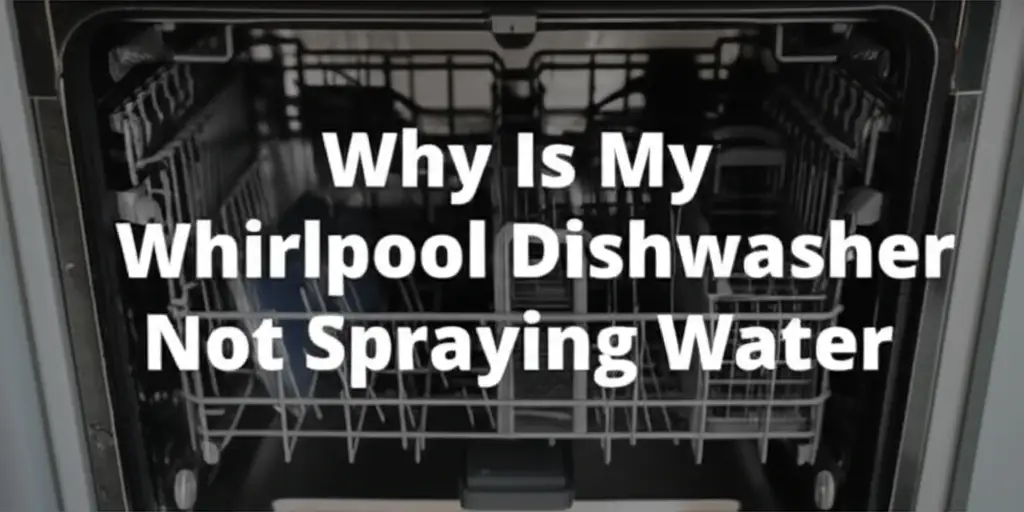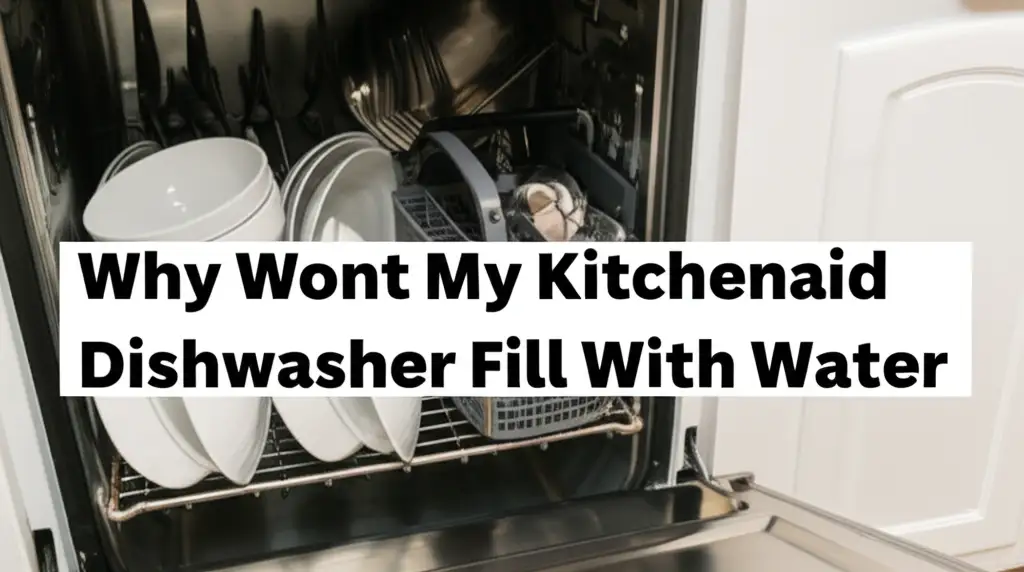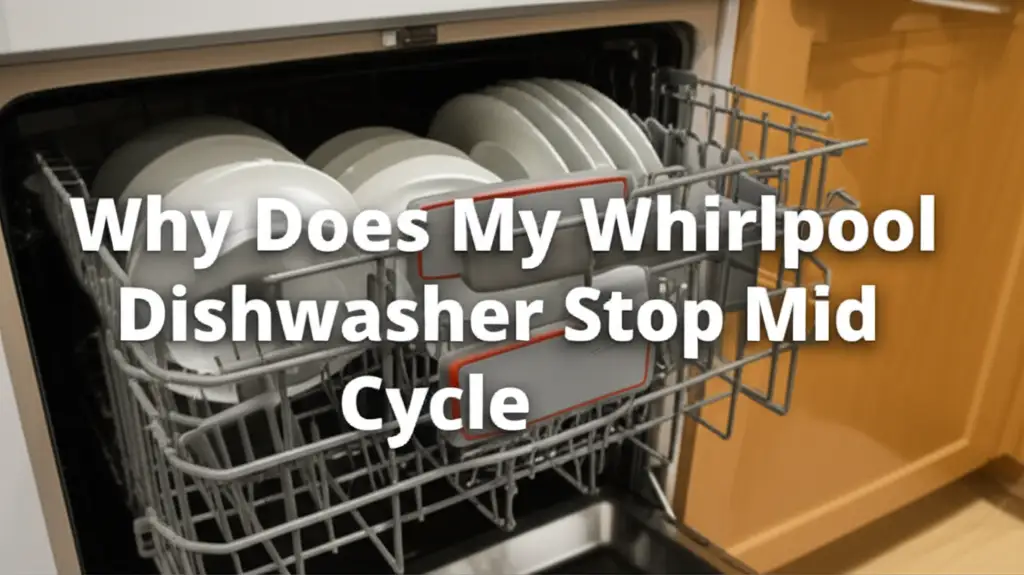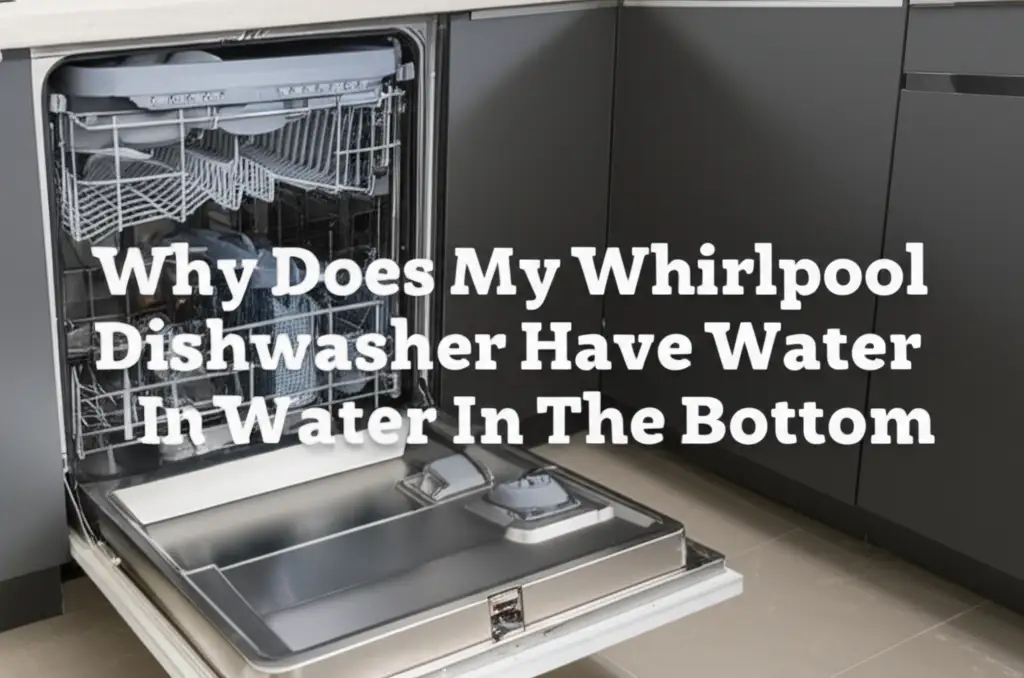· Katria Melrose · Appliance Repair · 15 min read
Why Is My Whirlpool Dishwasher Not Spraying Water

Whirlpool Dishwasher Not Spraying Water? Here’s Why.
Imagine opening your Whirlpool dishwasher, expecting sparkling clean dishes, only to find them still covered in food debris. This sight can be frustrating. A common reason for this problem is your Whirlpool dishwasher not spraying water during the wash cycle. This issue stops proper cleaning. It means the spray arms are not sending water across the dishes.
I understand how vital a functioning dishwasher is for a clean kitchen. When your Whirlpool dishwasher stops spraying water, it throws off your whole routine. This article explains the most common reasons why your dishwasher might not spray water. We will explore simple steps you can take to identify and fix the problem. You will learn about issues with water supply, clogged components, and pump problems.
Takeaway
If your Whirlpool dishwasher is not spraying water, consider these key steps:
- Check Water Supply: Ensure the water valve is open and the fill hose is not kinked.
- Inspect Spray Arms: Look for clogs or cracks in the spray arm nozzles.
- Clean Filters: Remove and clean the filter assembly to prevent water flow restriction.
- Verify Water Inlet Valve: Test the inlet valve for proper operation and water entry.
- Examine Wash Pump: Listen for pump sounds and check for impeller damage.
- Test Diverter Valve: Confirm the diverter valve directs water correctly to spray arms.
Clear Answer
Your Whirlpool dishwasher is not spraying water often because of a clogged spray arm, a faulty water inlet valve, or a malfunctioning wash pump. Debris in the filter or a kinked water line can also prevent proper water flow. Simple checks can help identify the issue.
1. Checking Water Supply and Inlet Valve Integrity
Water must enter your Whirlpool dishwasher for it to spray. If your dishwasher does not spray water, the first check involves the water supply. Water pressure issues or a closed water valve can prevent water from reaching the wash cycle. You need to confirm the dishwasher receives adequate water.
The water inlet valve is a critical part. This valve opens to allow water into the dishwasher from your home’s water line. If the valve fails, water cannot enter or enough water cannot enter the machine. This directly stops the spray arms from working. A faulty valve might be stuck closed or partially open. I always start here because it is a simple check.
1.1 Verifying Water Supply Line
Start by looking at the water supply valve. This valve is usually under the kitchen sink. It connects to the dishwasher’s fill hose. Make sure the valve is fully open. If it is closed, no water can enter.
Next, check the fill hose itself. A kink or twist in the hose can restrict water flow. Straighten any bends you find. Inspect the hose for visible damage or leaks. A damaged hose can reduce water pressure.
1.2 Inspecting the Water Inlet Valve
The water inlet valve is often located at the bottom front of the dishwasher. It has electrical wires and a water line attached. You should check the screen on the valve. Sediment can build up here and block water flow. Clean any debris you find.
A common sign of a faulty water inlet valve is that the dishwasher fills with little to no water, or does not fill at all. You might hear a humming sound, but no water enters. If your Whirlpool dishwasher fills with water but does not wash, the inlet valve might be working, but the problem lies elsewhere. However, if no water enters, the inlet valve is a strong suspect. Testing the valve with a multimeter can confirm if it receives power and opens correctly. If it does not open, replacing the water inlet valve is often the solution.
2. Inspecting and Cleaning Spray Arms
The spray arms are central to your dishwasher’s cleaning action. These spinning arms have small holes, or nozzles, that forcefully spray water onto dishes. If your Whirlpool dishwasher is not spraying water, these arms are a key area to check. Over time, food particles, hard water deposits, or detergent residue can clog these tiny holes. This blockage prevents water from escaping the nozzles and reaching your dishes.
When I see dirty dishes after a cycle, I immediately check the spray arms. It is a very common cause for poor cleaning performance. Clear pathways for water are necessary for effective spraying.
2.1 Removing and Examining Spray Arms
Your Whirlpool dishwasher usually has two or three spray arms: a lower arm, an upper arm, and sometimes a middle arm. They typically twist off or unclip easily. First, empty the dishwasher completely. Then, gently remove each spray arm.
Once removed, hold them up to the light. Look closely at all the small holes along the arms. You might see visible food debris, grease, or mineral buildup. Some arms may have caps that come off for easier cleaning.
2.2 Clearing Clogs from Spray Arm Nozzles
Cleaning the spray arms is straightforward. Use a thin wire, a toothpick, or a straightened paperclip to poke through each clogged hole. Push the debris out. Make sure the holes are completely clear.
After clearing the holes, rinse the spray arms thoroughly under a strong stream of tap water. Water should flow freely out of all nozzles. If the spray arm itself is cracked or damaged, it might leak water instead of spraying it. A damaged arm loses water pressure, leading to poor washing. In this case, you will need to replace the entire spray arm. Ensure the spray arms spin freely when you reattach them.
3. Addressing Clogged Filters and Sump Area
A crucial component in your Whirlpool dishwasher’s water circulation system is the filter. The filter catches food particles and debris, preventing them from recirculating and potentially clogging the spray arms or damaging the pump. If the filter becomes excessively clogged, it restricts the flow of clean water to the pump and spray arms. This restriction can cause your Whirlpool dishwasher to not spray water effectively, or at all.
This area is often overlooked, but it plays a big role in dishwasher performance. A dirty filter leads to poor cleaning and can even leave water standing in the bottom of the tub.
3.1 Locating and Removing Dishwasher Filters
Most Whirlpool dishwashers have a two-part filter system. There is typically a coarse filter and a fine filter (microfilter). You can find these filters at the bottom of the dishwasher tub, usually under the lower spray arm. They are often accessible without tools.
First, remove the lower dish rack. Then, carefully twist or unclip the filter assembly. Some models require you to remove the coarse filter first, which then allows access to the fine filter underneath. Be gentle when removing them to avoid damage.
3.2 Thoroughly Cleaning Filter Components
Once you have the filters removed, rinse them under hot running water. Use a soft brush or sponge to scrub away any trapped food particles, grease, or mineral buildup. For stubborn debris, you can soak the filters in warm, soapy water for a few minutes. Dish soap helps break down grease.
Ensure that all mesh screens and crevices are completely clear. A clean filter allows water to flow freely to the wash pump. This helps the spray arms work correctly. After cleaning, carefully reassemble the filter components. Make sure they are securely in place before running a wash cycle. If you notice your Whirlpool dishwasher has water in the bottom, a clogged filter is a very likely cause. A clear filter helps both spray and drain functions.
4. Diagnosing Wash Pump and Motor Issues
The wash pump is the heart of your Whirlpool dishwasher’s cleaning system. Its job is to force water through the spray arms with enough pressure to clean dishes. If your Whirlpool dishwasher is not spraying water, a malfunctioning wash pump or its associated motor is a serious possibility. The pump circulates the water that enters the tub, ensuring it reaches all parts of the dishwasher under pressure.
A failed pump means no water movement. No water movement means no spray. This is a more complex issue than a simple clog, but understanding its role helps in troubleshooting.
4.1 Understanding the Wash Pump’s Role
The wash pump consists of a motor and an impeller. The motor powers the impeller, which then creates the force needed to push water. If the motor fails, the impeller will not spin. If the impeller breaks, it cannot move water even if the motor runs.
Signs of a pump issue can include unusual noises, like grinding or humming without water circulation. Sometimes, the dishwasher will fill with water, but then it just sits there, never spraying. This indicates the pump is not doing its job.
4.2 Checking for Impeller Blockages or Damage
Before assuming the pump motor is bad, check the impeller. Sometimes, small pieces of glass, plastic, or hard food debris can get past the filter and jam the impeller. This prevents it from spinning freely. You may need to access the pump area, which is usually at the bottom of the dishwasher tub, often under the filter assembly.
Carefully remove any visible debris that might be stopping the impeller. If the impeller blades are broken or worn, the pump cannot create proper water pressure. You might need to replace the impeller or the entire pump assembly. This task often requires more technical skill or a professional.
4.3 Testing the Wash Pump Motor
If no blockages are present, the wash pump motor might be faulty. You can test the motor’s continuity with a multimeter. First, disconnect power to the dishwasher for safety. Then, access the motor and test its electrical connections.
A motor that does not show continuity is likely dead. Overheating can also damage motors, leading to intermittent or complete failure. Replacing a wash pump motor is a significant repair. This repair often costs more than simpler fixes. If you are not comfortable with electrical testing, contact an appliance repair technician. A professional can quickly confirm if the wash pump is the reason your Whirlpool dishwasher is not spraying water.
5. Considering Diverter Valve Malfunctions
Some Whirlpool dishwashers use a diverter valve. This valve directs water flow to different spray arms at different times during the wash cycle. For example, it might send water to the lower spray arm, then switch to the upper spray arm, or both simultaneously. This helps ensure comprehensive cleaning. If your Whirlpool dishwasher is not spraying water from all arms, or only from one section, the diverter valve could be the culprit.
A faulty diverter valve can prevent water from reaching specific spray arms. This leaves dishes in certain areas still dirty.
5.1 How the Diverter Valve Works
The diverter valve is typically located near the wash pump. It uses an internal motor or mechanism to shift water flow. Its purpose is to optimize water use and pressure for different washing zones. When it works correctly, you might notice varying levels of spray noise as water redirects.
If the diverter valve fails, it might get stuck in one position. This would only send water to one spray arm. Or, it could fail to engage properly, diverting no water to any arm. This could be a mechanical issue with the valve itself or an electrical problem preventing its operation.
5.2 Signs of a Faulty Diverter Valve
The main sign of a diverter valve problem is inconsistent spraying. For example, the lower rack dishes are clean, but upper rack dishes are still dirty. This indicates that the upper spray arm is not receiving water. Conversely, if only the upper arm works, the lower arm might be deprived.
Another sign is no spray at all, even though the wash pump sounds like it is running. The pump might be pushing water, but the diverter valve is not directing it correctly to the spray arms. Sometimes, you might hear clicking or grinding sounds from the valve area if it struggles to operate.
5.3 Troubleshooting and Replacing the Diverter Valve
Testing a diverter valve can be challenging. You would typically check for continuity to its motor or actuator if it is electrically operated. You also need to physically inspect it for signs of damage or blockage. Small debris can sometimes jam the internal mechanism of the valve.
If the valve is visibly damaged, or if electrical tests confirm it is not receiving power or not responding, replacement is necessary. Replacing a diverter valve often involves accessing the pump assembly. This can be complex. If you are unsure, calling a qualified technician is a good idea. They have the tools and experience to properly diagnose and replace this part, ensuring your Whirlpool dishwasher sprays water effectively again.
6. Investigating Control Board or Sensor Faults
While less common than mechanical issues, electronic problems can also cause your Whirlpool dishwasher to not spray water. The control board acts as the dishwasher’s brain. It sends commands to various components, including the water inlet valve, wash pump, and diverter valve. If the control board malfunctions, it might fail to send the correct signals for water circulation.
Sensors also play a role. A faulty water level sensor, for example, might incorrectly detect too much or too little water. This can prevent the spray cycle from initiating.
6.1 Understanding the Role of the Control Board
The control board manages every phase of the wash cycle. It tells the water inlet valve when to open, the wash pump when to activate, and the diverter valve when to switch. If it glitches or fails, these components will not receive the necessary instructions.
A sign of a control board issue might be erratic behavior. This includes cycles that do not complete, buttons that do not respond, or strange error codes. Sometimes, a simple power reset can fix minor board glitches. Unplug the dishwasher for a few minutes, then plug it back in. This can sometimes reset the electronics.
6.2 Examining Water Level Sensors
The water level sensor tells the control board how much water is in the tub. If this sensor is dirty or faulty, it might send incorrect readings. For instance, it might tell the control board that the tub is full when it is not, or vice versa.
If the dishwasher thinks there is no water, it will not activate the wash pump. This stops the spray action. You can often find this sensor at the bottom of the tub. Check it for debris or grime. Clean it carefully if it looks dirty.
6.3 Diagnosing and Replacing Electronic Components
Diagnosing control board and sensor issues often requires specialized knowledge and tools. A faulty control board usually needs replacement. This can be an expensive repair. Before replacing, confirm all other mechanical parts are working correctly.
If you suspect an electronic component, check your dishwasher’s user manual for specific error codes. These codes can point to the exact problem. If you are not experienced with electrical testing, it is best to call a professional appliance technician. They can accurately diagnose complex electronic failures. Fixing electronic issues often means the difference between a silent wash cycle and a properly spraying Whirlpool dishwasher.
FAQ Section
Q1: Why does my Whirlpool dishwasher fill with water but not spray?
If your dishwasher fills with water but does not spray, the issue likely points to the wash pump or a clogged spray arm. The water inlet valve successfully allows water in, but the pump fails to circulate it under pressure. Also, check for debris blocking the impeller or spray arm nozzles.
Q2: Can a clogged filter stop a dishwasher from spraying water?
Yes, a severely clogged filter can stop your dishwasher from spraying water. The filter traps food particles, and too much buildup restricts water flow to the wash pump. This reduces the water pressure needed for the spray arms to function effectively, leading to poor cleaning.
Q3: How do I know if my dishwasher’s water inlet valve is bad?
A bad water inlet valve might prevent water from entering the dishwasher at all. You might hear a buzzing sound but no water. Another sign is very slow water fill. If you suspect the valve, disconnect power and check for clogs in its screen or test its electrical continuity.
Q4: Is it safe to try fixing a dishwasher not spraying water myself?
Simple fixes like cleaning spray arms or filters are safe for homeowners. Working with water lines and electrical components requires caution. Always disconnect power before attempting repairs. For complex issues involving pumps or control boards, consider hiring a professional technician.
Q5: How often should I clean my Whirlpool dishwasher’s filters?
You should clean your Whirlpool dishwasher’s filters regularly, ideally once a month or every few weeks. This frequency prevents food debris buildup. Regular cleaning ensures optimal water flow and spray pressure. It also extends the life of your dishwasher and prevents common problems like poor cleaning or water remaining in the tub.
Conclusion
Discovering your Whirlpool dishwasher is not spraying water can be a frustrating experience. However, most causes stem from common issues that you can often troubleshoot yourself. We have covered the critical areas: the water supply, the condition of your spray arms, the cleanliness of the filters, the function of the water inlet valve, the performance of the wash pump, the role of the diverter valve, and potential electronic faults.
By systematically checking these components, you stand a good chance of diagnosing the problem. Remember to always disconnect power before attempting any repairs. Simple maintenance, like regularly cleaning your filters and spray arms, can prevent many of these problems from starting. If the issue persists after your checks, or if you feel uncomfortable with a repair, a certified appliance technician can help. Restoring your Whirlpool dishwasher’s spray power means getting back to clean dishes and a smooth kitchen routine.





